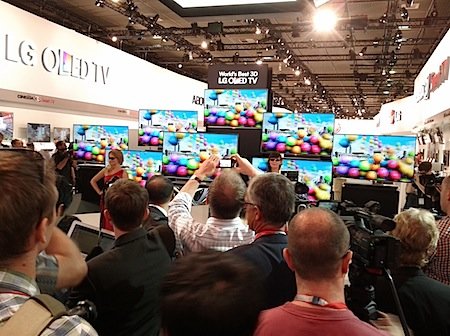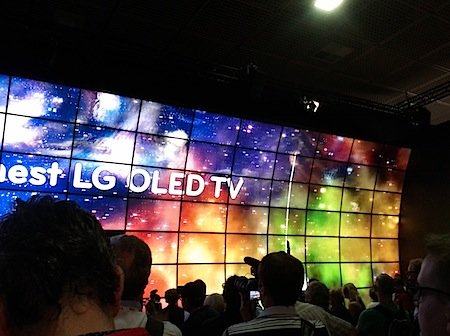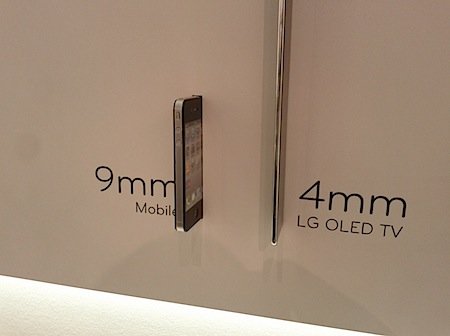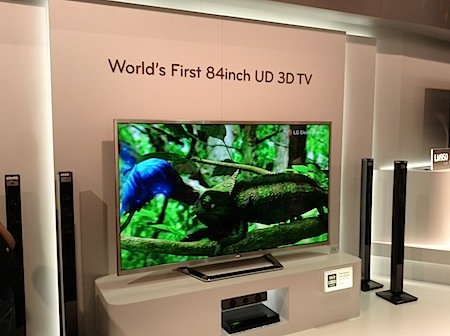
Trips to the local electronic superstores in Amman will be a frustrating experience for me in the coming few years. Why? Because I seen the future of TV screens at the Berlin’s IFA consumer electronic expo. That future is big, it’s high resolution, it’s 3D and it’s smart.
LG invited me to the IFA consumer electronic show in Belin where it was showing off its latest TV innovations and I gladly obliged. Berlin is one of my favorite cities in the world, and, as I have no inclination to ever fly to Las Vegas for the big Consumer Electronic Show, I decided that a trip to The IFA is worth it.
Needless to say, all the big electronic companies where there (except Apple, which just doesn’t attend these shows). But my IFA experience started at the LG stand.
The race in television technology this year has been around two technologies mainly. The first is OLED screen technology and the 2nd is about bringing an 84″ “4k resolution” to the consumer market.

Every TV manufacturer at the IFA was aiming to dazzle. LG’s wow effect at its both was created by a massive, really massive video wall made out of hundreds of flat screens with really thin bezels. Everyone entering the Massive LG exhibition stand was asked to wear on of the company’s light weight “passive” 3D glasses. Then, the crowd was hit by a massive 3D experience on that incredible video wall.
We were assaulted by 3D renditions of everything from flying books to an exploding city to planets and I have to say the effect was quite amazing. One of my issues with the show is that it seemed to be more concerned with just dazzling you with one 3D scene after the other, with no real narrative or story. Still, it was something!
But while such 3D video walls might be an interesting demo, especially for the use in museums or other venues, I was there to see what kind of TV I can expect to have at home in the coming few years.
OLED: very thin design and very black blacks!
One of the answers from LG to that question is OLED: in the shorter term, the company will start to market its OLED TVs around the world. This will actually start towards the end of the year, but there was no firm release date and pricing for the Middle East.
But before we get into that, what is the big deal with OLED? OLED stands for Organic Light Emitting Diode technology. This is a fundamentally different technology than your typical LCD TV. Both LCD and OLED TVs use millions of little pixels to create your TV image. But this is where the similarities end. An LCD TV has a so-called back-light, an array of light elements that are on all the time. In front of this back light there is a layer made of liquid crystal pixels that can be turned on and off to let light go through or stop it. The problem is that you cannot keep the light out completely. In practical terms this means that even if you are looking at a very dark night scene in a movie, the black sky will not appear totally dark on your LCD TV. LCD TVs have gotten better through the years at displaying darker blacks, but OLED basically blows the socks off LCDs in that area.
That’s because OLED TVs don’t have a massive backlight in the back. Each OLED pixel is like a tiny light bulb that can be turned on and off. So when it’s off it’s basically a deep, dark black.
Here is a good video that explains what OLED is all about
LG was showing off it’s gorgeous OLED TVs, and, as expected it was using demo films with lots of black backgrounds, against which all kinds of vibrant objects where displayed.
The deep back of OLED TV’s is really amazing.
Furthermore, OLED TVs can be manufactured as really thin screens. LG’s 55 OLED TVs are just 4mm thin. That’s half the thickness of the iPhone. It is quite unbelievable.
Have a look at this to get a sense of what I am talking about

That’s all the good news. The bad news is that these OLED TV’s will be expensive.
Judging from what I read around the web, I guess a 55″ OLED TV will be around JD 8000-9000 when released in Jordan.
But if you think that 30″ OLED screens cost twice that just a few years ago and if you remember how fast the price of big screen LCDs has come down in the last few 5 years, then you could predict that OLED TVs could become a mainstream item in the next 3 years or so.
Expect to see demo units of LG’s 55″ OLED TVs in Jordan and the Levant soon. And prepare to be dazzled (and frustrated if you can’t afford them!).
The race for 4K

The other big news for LG at IFA was its 84″ 4K TV. The company has released this as an actual consumer product in its home market Korea a little while ago.
You will hear the term “4K” a lot in the coming years, because that seems where the industry sees the next mile stone. So what the heck is 4K?
Well, imagine 4 full HD 42″ TVs stuck together as one huge screen. That’s basically 4k.
Hollywood movies, when shot digitally, are shot at 4K resolution. 4K TVs will bring that kind of cinema-like experience to the home. From what I’ve seen at the IFA I have a feeling that in 4 to 5 years that kind of experience will become more common, if not mainstream.
When I asked Ken Hong, LG’s Global Communications Director about why LG was bringing a A 84″ 4K to the market when in fact there are no 4K Bluray discs (or much downloadable content) for consumers to buy, he immediately answered that a company like LG will not wait for content to emerge, but instead will push the market forward aggressively.
Of course, you can watch conventional HD content (like a Bluray or a movie downloaded from iTunes) on a 4K TV. LG and others will all tell you that they have built special “upscaling” software into their TVs and/or Bluray players that enhance the appearance of a TV image stretched from 2 million pixels in a full HD frame to the 8 million of a 4K frame, but that’s, of course, just a temporary fix until movie studios come out with 4K content.
The race for higher screen resolutions is on. It’s not just on you TV screen. If you think that the iPad, with its small screen of 10 inches, packs a million more pixels than your 42″ TV FullHD screen you start getting an idea where all of this race is headed.
For now, a 84″ 4K TV from LG will cost you around US$ 20,000 in Korea. At that price, I only expect to see it in houses of the super-rich and maybe in the board rooms of big corporations. But at least we can say the next milestone of home-cinema experience is on the visible horizon.
I will be writing more posts about what I saw at the IFA in the coming few days, but for now I will keep it at that.
Comments
One response to “55″ OLED TVs and 84″ 4K screens: the next evolutions of TV are here”
2K is the current HD standard but it is useless in the Middle East because most programming is still in old fashioned SD format of old TVs. One can watch pay for view soccer matches or Bluray discs. 4K is great but not to the average Arab viewer.